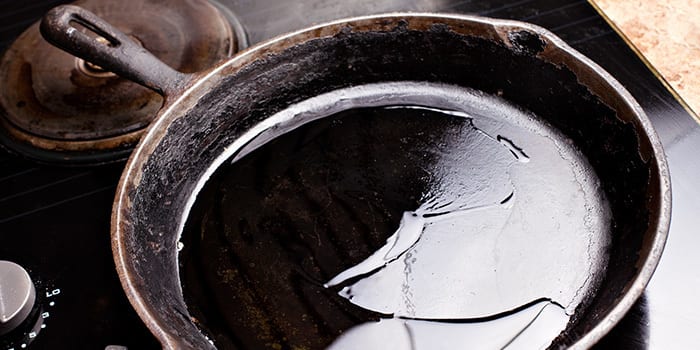How to Season Cast-Iron Pans

A well-seasoned cast-iron pan is a treasure. If you put in just a little effort every once in a while to develop and maintain the seasoning of your pan, you’ll be rewarded with one that cooks food perfectly and lasts a lifetime.
Cast-iron pans must be maintained because they’re made from a naturally porous surface that, if exposed to water can quickly rust. Left unused in a cupboard, pans may gradually rust from the moisture in the air. The seasoning process fills those pores in the surface of the metal with fat, thus sealing out oxygen and moisture. Then, when baked, the fat forms a bond with the pan that creates a smooth cooking surface that gets better over time.
You should season new pans before their first use and I recommend re-seasoning them from time to time to keep them in top condition. If your pan is very rusty, it can be restored to shiny black, but it may need to be scrubbed several times. If the rust persists, a machine shop can sandblast the rust leaving you with a new, clean surface that is ready to be seasoned.
How to Season Cast-Iron Pans
1. Heat your oven to 325°F. Position one rack in the center position, and another rack below.
2. Wash the pan thoroughly with soap and a scouring sponge or brush. Rinse.
3. Dry the pan thoroughly with towels or place over a lit burner or in a hot oven for several minutes. Allow the pan to cool for safe handling.
4. Pour about a tablespoon of oil into the pan (any cooking oil will do) and use a clean cloth or paper towel to spread it around the entire inner and outer surface of the pan, even the handle.
5. Place the pan upside down on the oven’s top rack, and place a sheet pan or aluminum foil on the rack below to catch any drips.
6. Leave the pan in the oven for an hour and then turn off the oven. Let the pan cool completely in the oven before removing.
7. Admire your beautiful cookware.
8. Follow our instructions for cleaning to protect the pan’s seasoned surface.
Repeat this process as often as needed to keep your pan shiny, with a smooth, nonstick surface. If foods start to stick, or if the cooking surface becomes dull or rusted, it’s time to re-season.
